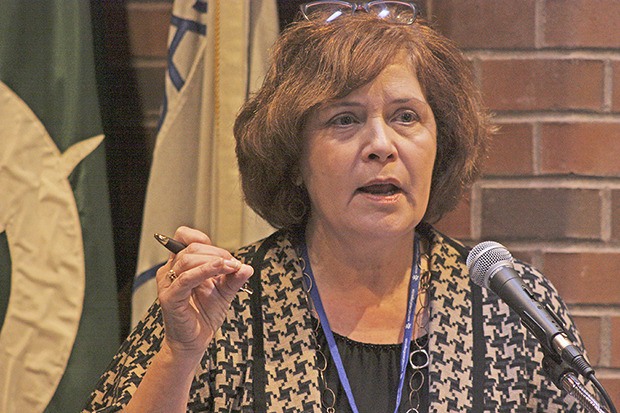Human trafficking is alive and growing all too well in South King County.
Let Kent Police Chief Ken Thomas explain.
An undercover sting operation made 31 arrests during a 10-hour shift last year. Authorities netted 27 arrests for solicitation and trafficking on another night.
Among the buyers? A 17-year-old boy who attends a Kent high school.
So many buyers were booked and victims rescued that it tapped out police resources, ultimately resulting in a wave of cases that swamped the court system.
A market-driven criminal enterprise, the human sex and slavery industry remains a growing problem, a local crisis that has spread beyond Pacific Highway and side streets to the deep and wide abyss of the Internet.
“The demand is off the hook. There is a ton of (buyers) out there,” Thomas told a group of leaders and representatives from agencies committed to stopping the problem at a community forum at Kent City Hall on Feb. 4. “This is such a big problem, and it (attracts) people from all facets of life. … This problem sees no borders, no barriers. It’s a huge problem, and the only way we can work toward changing it is by changing the attitude, changing the culture.
“We need to say it’s not right,” Thomas said. “We need to bring awareness to the problem, awareness to the issues and deal with it appropriately.”
Kent Police hosted and the South East King Coalition Against Trafficking (SEKCAT) sponsored the forum – “Beneath the Surface”, an update on human trafficking in the area. The meeting brought together law enforcement, education, social service and other agencies that are trying to better coordinate efforts to fight human trafficking.
One approach
All sides agree that the prevailing approach is to bring and improve awareness, education and training to those willing to stem the tide.
“We want to be multi-faceted in our area,” said Lorna Rufener, a retired Kent Police officer who helped form SEKCAT along with Linda Myers, a retired Auburn schoolteacher. “Such a better, more multifaceted approach and response to the trafficking of young people in South King County (is important).”
According to the U.S. Department of Justice, human trafficking has become the second fastest growing criminal industry – just behind drug trafficking – with children accounting for roughly half of all victims. And Washington state remains a hotbed for human trafficking. The state’s international border with Canada and its many ports make Washington prone to such exploitation, according to reports.
Seattle Against Slavery, a grassroots coalition working to mobilize the community in the fight against sex and labor trafficking, reported 200 youths in the area were trafficked in the last two years.
Washington Engage, a nonprofit organization, is focused on preventing human trafficking and protecting those who are vulnerable. The group is provided the foundation in partnering with area CATs (coalition against trafficking) to combat and prevent the problem through education, programs and combined resources.
“There is so much going on in our area. There is so much that we are doing and that we can do,” Frances Walker-Dudenhoefer, executive director of WA Engaged, told the group at the forum.
The city of Kent is trying to do its part. Fines and other associated assessment fees for those arrested and charged for prostitution have gone back into the community to support the victims and survivors and aid further enforcement, Thomas said. Police have put between $15,000 and $20,000 back into support programs in each of the past two years, he said.
As human trafficking has changed, so too have the laws and police tactics.
Kent Police are now enforcing a new ordinance that essentially requires massage parlors and its employees to operate with appropriate licenses and certifications. Failure to do so will lead to misdemeanors and fines, Thomas said.
Police remain steadfast in going after the major traffickers, but going after a nuisance, backpage.com, has been another matter.
During last year’s sting, a disguised, police-posted classified advertisement in the adult listings on backpage.com attracted more than 80 inquiries in less than four hours. The ploy led to a dizzying number of arrests that stretched the police force, Thomas said.
The website, Thomas insisted, is “about 99 percent” set up to manage illegal trafficking.
“In my opinion, the only reason for its existence is to further human trafficking,” he said. “It makes no sense at all why we as a government or as we as people tolerate something like backpage.com that does so much damage to members of our society.”
Other strategies
Washington Engage and coalitions are focusing their attention to preventative and early intervention work.
It is using the Deceptions Program for youth education, an age-appropriate presentation that increases adolescents’ awareness of youth sexual exploitation and trafficking and Internet safety through a brief education series. It has used Deceptions in the Federal Way School District for nearly three years, training more than 9,000 students and receiving strong endorsements from school administrators. Washington Engage is training school personnel to implement and facilitate the program in their schools.
“It’s happening in our schools. It’s hidden in plain sight,” Walker-Dudenhoefer said. “Once you have been educated, once you know about human trafficking, you start seeing it.”
Training is also available for professionals to identify the signs of trafficking in their patients, students and clients.
In 2015, WA Engage provided education and training on human trafficking to more than 1,600 professionals and community members.
The effort continues in the Legislature, where coalitions are urging lawmakers to get tougher on trafficking.
And it’s all about reaching the masses.
“Getting the word out is important,” Rufener said.
===
Need help?
For resources and assistance, please check out:
Talk to us
Please share your story tips by emailing editor@kentreporter.com.
To share your opinion for publication, submit a letter through our website https://www.kentreporter.com/submit-letter/. Include your name, address and daytime phone number. (We’ll only publish your name and hometown.) Please keep letters to 300 words or less.

